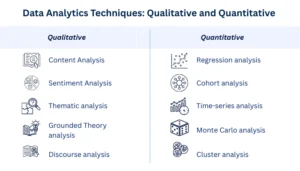Over the last few decades, the world has undergone significant evolution. With numerous technologies and tools for convenience, the demand for convenience has increased significantly. With multiple businesses coming into play, even the competition has increased tremendously. With modern age consumer demands, businesses are also expected to evolve accordingly. The greatest treasure businesses can utilize in modern times is the vast amount of data. If you are a business owner and wish to use the data for exponential business growth, this guide is for you. Go through this comprehensive guide to data analysis, its benefits, and use cases before considering data analysis services for your business.
What is Data Analysis?
Data analysis is the complete method of collecting, cleaning, organizing, and extracting useful information from data. This procedure helps convert raw data into useful business insights, which can be used to formulate powerful strategies and support decision-making. It is a complex process that involves various techniques and methodologies to interpret data from different sources and formats. It involves both structured and unstructured data.
If, as a business owner, you are wondering how data analysis can help you, then let’s look at some examples. Suppose you have a large amount of customer data, like their purchase history, preferences, and patterns, etc. Data analysis can help you derive information like which of your products is best-selling, what causes customer churn in your business, and what marketing strategy will work on your customers. Imagine the amount of improvement data analysis can offer in your organization by revealing the information locked in your data. It will not only help increase sales, but also help you address customer concerns better. Thus, data analysis is a powerful tool for businesses, both product-based and service-based.
Why Do Businesses Need Data Analysis?
Data analysis has always existed, in the form of experienced decision makers, guessing future patterns based on historical patterns. However, human predictions are prone to errors and biases based on belief systems. On the contrary, modern data analysis is a data-driven, practical approach to better decision making. Below are the major reasons why businesses need data analysis services:
-
- Data Driven Decision Making
-
- Customer Behavior Insights
-
- Operational Efficiency by time and cost saving
-
- Risk Reductions
-
- Personalized Marketing with better ROI
Switch to smarter, data-driven decisions using the right data analysis approach for your business growth.
Types of Data Analysis
As mentioned above, data analysis is a complex process involving multiple phases and has many types. Here, we shall discuss types of data analysis and how they can be used for improving business.
Descriptive Analysis
Descriptive Analysis provides reports of what happened in history. It is a summary of sales, customers acquired, inventory, and other things that happened in the past month, or past year, etc. Descriptive analysis offers an opportunity to look into and keep track of whatever is happening in the organization through solid reports.
Diagnostic Analysis
Diagnostic Analysis, as the name suggests, identifies the cause of why something happened. It works on historical data, but provides deeper insight into the root cause of any profits or losses to the business. If a business is experiencing high customer churn, then this type of analysis helps identify patterns and, as a result, extracts the reasons for churn. Diagnostic analysis is a good approach for business planning to improve its impact in the market. This approach helps understand the aspects of changes required in their organization.
Predictive Analysis
Predictive Analysis is the astrologer of the data analysis family. However, its predictions are based on historical and real-time data rather than the stars. Predictive analysis deals with future probabilities. It warns business owners about the events that are most likely to happen in the future. For example, there’s a sudden technology surge in your field and your industry, and your products or services are not up to date. In such cases, predictive analysis will help you understand the rate of customer churn, decline in sales, and overall losses that the organization may have to face. Predictive Analysis also helps understand the impact of decisions by creating a hypothetical report of its consequences.
Prescriptive Analysis
Prescriptive Analysis is like a business consultant or a wise advisor. This approach of data analysis provides businesses with corrective measures or steps that can benefit the business in the future. It takes into account all the drawbacks of your business through the available data and gives suggestions that are practical and can make a positive impact on your business growth.
Explanatory Analysis
Explanatory Analysis helps identify hidden patterns in your data. This may look simple, but knowing the customer pattern helps understand their preferences. This can help business owners and marketers prepare a better strategy for customer retention and satisfaction.
How Does the Data Analysis Process Work?
The data analysis is a multi-phase process. Let us go through a step-by-step overview of how data analysis works when a business hires a data analysis service provider.
-
-
Discovering Goals
-
The first step a data analyst will take towards your business’s data is understanding your requirements. To use the right approach and appropriate techniques, they need to understand your goals, KPIs, and problems you need to address.
-
-
Data Collection
-
The next step includes collecting data from various sources. The data can be raw, structured, or unstructured, but relevant to your business. This data makes up the entire base of the data analysis process, so it is important to cooperate with the data analytics service provider and provide everything they require.
-
-
Cleaning and Preparing
-
The gathered data needs to be cleaned and prepared for ingestion into the business analytics tool. This process of cleaning and preparing also ensures the gathered data is useful and reliable for the information we need to extract from it, or not.
-
-
Analysis & Modeling
-
This is a crucial step for the data analysis process, as in this process, the right techniques are applied to the prepared data. This step is the real process of analysis. Unlike traditional data analysis, new advanced and artificial intelligence tools make this process quicker and more accurate.
-
-
Insight Delivery
-
Once the analysis is completed, the results need to be delivered to the business owners. This can be done through reports or dashboards. These results help decision makers and stakeholders visualize the condition of their business.
-
-
Action Plan
-
Some business intelligence services go beyond the analysis and insight delivery to suggest an action plan. They help you understand the results and how to address the current issues in the organization.

Benefits of Data Analysis
When a business chooses to implement data-driven plans for growth and improvement, it can expect to see:
-
- A reduction in customer churn- Owing to the diagnostic approach of data analysis, if businesses can identify the reason for their customer churn, they can take actions to reduce it.
-
- Increase in ROI from marketing- Data analysis helps businesses understand their customers better. This facilitates improved marketing strategies with higher conversion.
-
- Streamlined operations – By recognizing challenges and addressing them, data analysis can help streamline the smooth operation of processes in your organization.
-
- Lesser bottlenecks- Identifying bottlenecks through data analytics services, companies can effectively de-bottleneck.
-
- Faster decision-making- Decision-making does not need to be a blind shot when you have solid data-driven reasons to back your decisions. Such decisions are more effective and practical.
With these benefits, companies can acquire 23 times more customers, 6 times more customer retention, and 19 times more profits.
Common Data Analysis Techniques
-
- Regression Analysis
-
- Factor Analysis
-
- Monte Carlo Simulation
-
- Cluster Analysis
-
- Cohort Analysis
-
- Time-series Analysis
-
- Sentiment Analysis
How AnavClouds Analytics.ai Can Help?
AnavClouds Analytics.ai is an AI development company known for its excellent generative AI services and data analysis services. Our team of data scientists, data analysts, and experienced professionals can help boost your business’s growth. We also integrate AI in data analytics to provide efficient and more accurate results for your business.
Conclusion
Data Analysis is a complex but very useful process for every business. It helps businesses, governments, and even other kinds of organizations identify their challenges, causes, and corrective measures. Data Analysis is a powerful tool that can transform your data into a growth boost for your business. Get in touch with some reliable and experienced data analysis service providers. AnavClouds Analytics.ai is here to help you with data strategy consulting. Book a demo with us soon.
FAQs
What are the benefits of data analysis?
Data analysis promotes innovation, enhances customer satisfaction, and gives solid data backing for practical decisions. Data analysis also improves ROI from marketing by understanding customer preferences.
What purpose does the data analysis process serve?
The ultimate goal of data analysis is to support data-driven decision making in the improvement of businesses or organizations.
What are the 5 steps of data analysis?
The main steps in data analysis are defining goals, collecting data, cleaning and preparation, analysis and modelling, and, at the end, result visualization.
What are the 4 main types of data analysis?
The 4 main types or approaches to data analysis are prescriptive, predictive, descriptive, and diagnostic.



